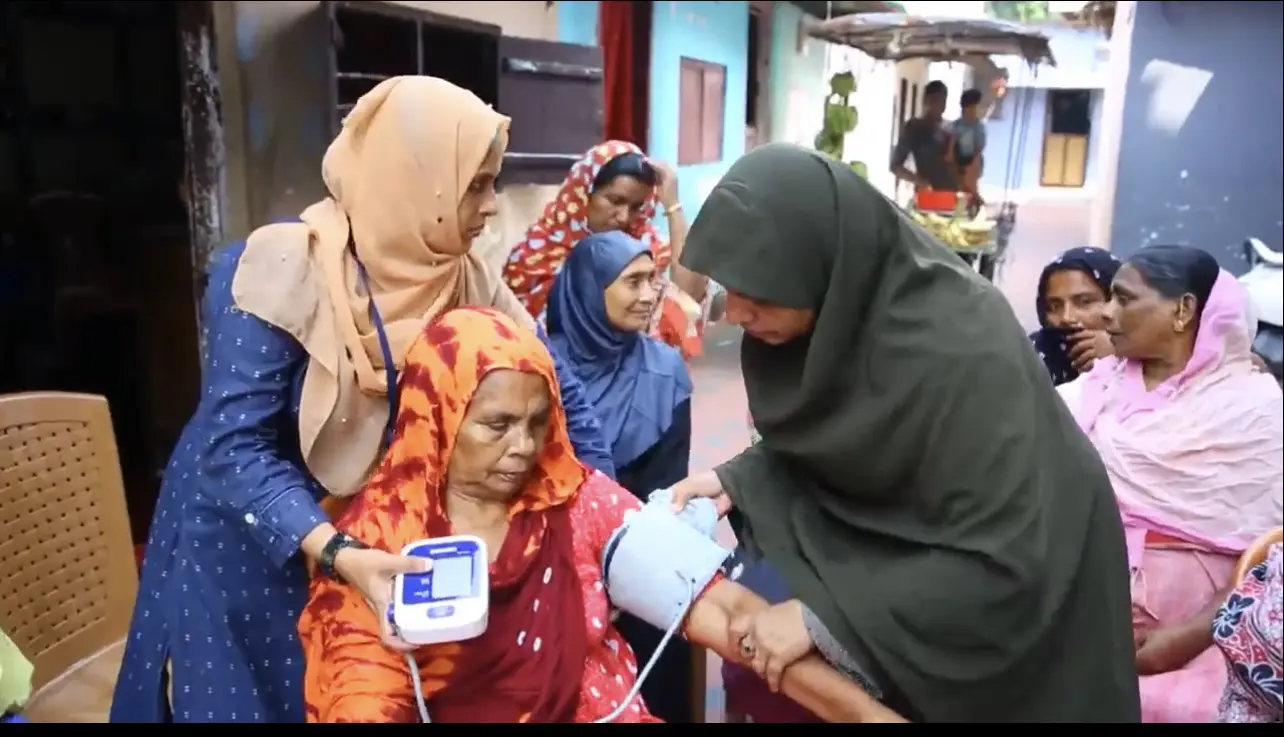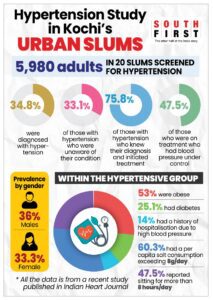The prevalence of hypertension in these urban slums has been attributed to high rates of obesity, excessive salt intake, and physical inactivity.

By involving members of women self-help groups, there was an effort to reduce hypertension within the urban slum community in Kochi, Kerala. (Supplied)
With soaring rates of obesity, sedentary lifestyle, and poor dietary habits, urban slum populations in India are now increasingly suffering at the hands of a silent killer — hypertension.
According to a study done by researchers at the Amrita Institute of Medical Sciences in Kochi, one in three adults in the urban slums of Kochi has hypertension. The prevalence of hypertension in these urban slums has been attributed to high rates of obesity, excessive salt intake, and physical inactivity among the population.
“Awareness, treatment initiation, and control rate of hypertension are lower in urban slums compared to non-slum urban areas. Slums require additional attention to ensure equitable and universal access to hypertension control,” stated the study.
While this study was done last year, the results were published recently in the Indian Heart Journal.
To gather data for the study, trained nurses conducted a door-to-door survey and measured the blood pressure of 5,980 adults from 20 randomly-selected slums in Kochi.
Out of the screened individuals, 2,074 were found to have hypertension, resulting in a prevalence rate of 34.8 percent.
Surprisingly, 33.1 percent of those with hypertension were previously unaware of their condition — diagnosed for the first time during the survey. Among those who were aware of their hypertension, 75.8 percent initiated treatment, and of those who started treatment, 48.4 percent had their blood pressure under control.
The researchers noted that awareness about hypertension status, treatment initiation status, and the control rate among those in treatment in the current study are higher compared to the urban population of the rest of the country.
The reason for high awareness in urban slums is attributed to literacy among citizens and improved accessibility to healthcare facilities, stated the study.
“Near universal literacy among citizens, increased access to health facilities established through National Urban Health Mission (NUHM), and a proactive healthcare system in both public and private sector that screens for high blood pressure could be the reason for higher awareness about hypertension status and treatment initiation status and control rates among the residents of urban slums in Kerala, when compared with reports from other states,” Dr Rakesh PS, the lead researcher of the study, told South First.
However, he added that, in contrast, the control rate among individuals who have commenced treatment in these urban slums is considerably lower when compared to data from neighbouring non-slum urban areas in Kochi (48 percent versus 75 percent) and another recent study involving school teachers (48 percent versus 67 percent).
“This disparity in control rates within slums may be attributed to several factors, including the overall lower prevailing health status in these areas, a lesser perceived need for control, and a lower quality of healthcare available in slums compared to non-slum urban areas,” said Dr Rakesh.
Overall, only 24.5 percent of the hypertensive population had their blood pressure under control.
Within the hypertensive group, 53 percent were obese, 25.1 percent had diabetes mellitus, and 14 percent had a history of hospitalisation due to high blood pressure. On average, individuals spent ₹667 per month out of pocket for hypertension treatment.
 The prevalence of hypertension increased with age, and males (36 percent) had a higher prevalence compared to females (33.3 percent). Alarmingly, among those identified with hypertension, 36 percent had not checked their blood pressure in the past year and 46 percent had never sought medical consultations for hypertension management.
The prevalence of hypertension increased with age, and males (36 percent) had a higher prevalence compared to females (33.3 percent). Alarmingly, among those identified with hypertension, 36 percent had not checked their blood pressure in the past year and 46 percent had never sought medical consultations for hypertension management.
The study also revealed that 80.3 percent of participants agreed that reducing salt intake could help lower blood pressure, 40.3 percent believed quitting tobacco could have the same effect, and 53.1 percent believed regular exercise could reduce blood pressure.
“The presence of risk factors such as high salt intake, low consumption of vegetables and fruits, a high proportion of obesity, sedentary lifestyles, and comorbidities among individuals with hypertension in urban slums demands attention,” stated the study.
Hypertension is the leading risk factor for global disease burden. Inequalities in health among urban poor and non-poor is a matter of concern. The current study was done to estimate the prevalence of hypertension and to describe the health-seeking and risk factor profile of people with hypertension in the urban slums of Kochi in Kerala.
The researchers attempted to address the prevalence of hypertension in urban slums of Kochi through a community-based approach involving education and peer support led by women self-help groups (SHGs).
By involving members of women SHGs, there was an effort to reduce hypertension within the community by empowering them as peer educators. This approach has the potential to be a cost-effective and flexible method to complement formal healthcare support, while ensuring active community participation in health promotion, noted the study.
The study recognised the strengths of existing units like Kudumbashree and found this approach to be effective. It is worth noting that similar community structures or groups exist in other slums, even if they may not be specifically named Kudumbashree.
The key message conveyed is that establishing a “community partnership” is the solution and the formal healthcare system should make intentional efforts to engage the community through various means.
Rakesh PS added that his team has been working with urban slums to minimise inequalities in urban health among urban poor and non-poor through their urban health initiatives.
“We have also noticed that many of the slum dwellers who attended our urban health clinic/outreach camps presented with uncontrolled high blood pressure and complications of hypertension, such as stroke and retinopathy,” said Dr Rakesh.
He added that to effectively manage non-communicable diseases (NCDs) like hypertension, there is a need to enhance the capacity of formal healthcare systems and ensure the uninterrupted supply of essential medications for NCDs.
Dr Rakesh stated that adopting a people-centric approach is vital when dealing with NCDs, placing individuals at the forefront of care. Moreover, it is essential to prioritise, systematically engaging the community and transforming it into a collective effort against NCDs.
In the study, a significant percentage of individuals with hypertension had never sought medical consultations for hypertension management.
“These are not an issue of slums alone; this is the same across all geographies. This is because of the silent nature of the disease. Hypertension is called as a ‘silent killer’. If we have a fever, we can feel the temperature. If we fall, we can feel the pain. People will seek care when they feel something. However, hypertension is something silent. Only when complications emerge, people will ‘feel’ something,” said Dr Rakesh.
He said that building awareness about the silent nature of hypertension and its potential complications are something that is urgently required. Again, such communication and social mobilisation campaigns need to be sustainable and community ownership is the key to make it sustainable.
The study also found that 60.3 percent had a per capita salt consumption exceeding 8g/day, and 47.5 percent reported sitting for more than eight hours per day, and and 9.6 percent were current smokers.
“At home, it is not easy to cook without salt for one person and with salt for others. There will be challenges. The best intervention is to reduce salt for the entire household. It is possible only through a ‘kitchen revolution’ and with the help of whole family,” Dr Rakesh stated.
About exercise, he said that lack of self-motivation, non-enjoyment of exercises, fear of being injured or bitten by dogs during early morning walks, lack of self-management skills such as ability to set personal goals, lack of encouragement, support, companionship from family, non-availability of public places such as parks/sidewalks are some of the reasons for physical inactivity.

May 17, 2024

May 17, 2024

May 16, 2024

May 16, 2024

May 16, 2024

May 16, 2024